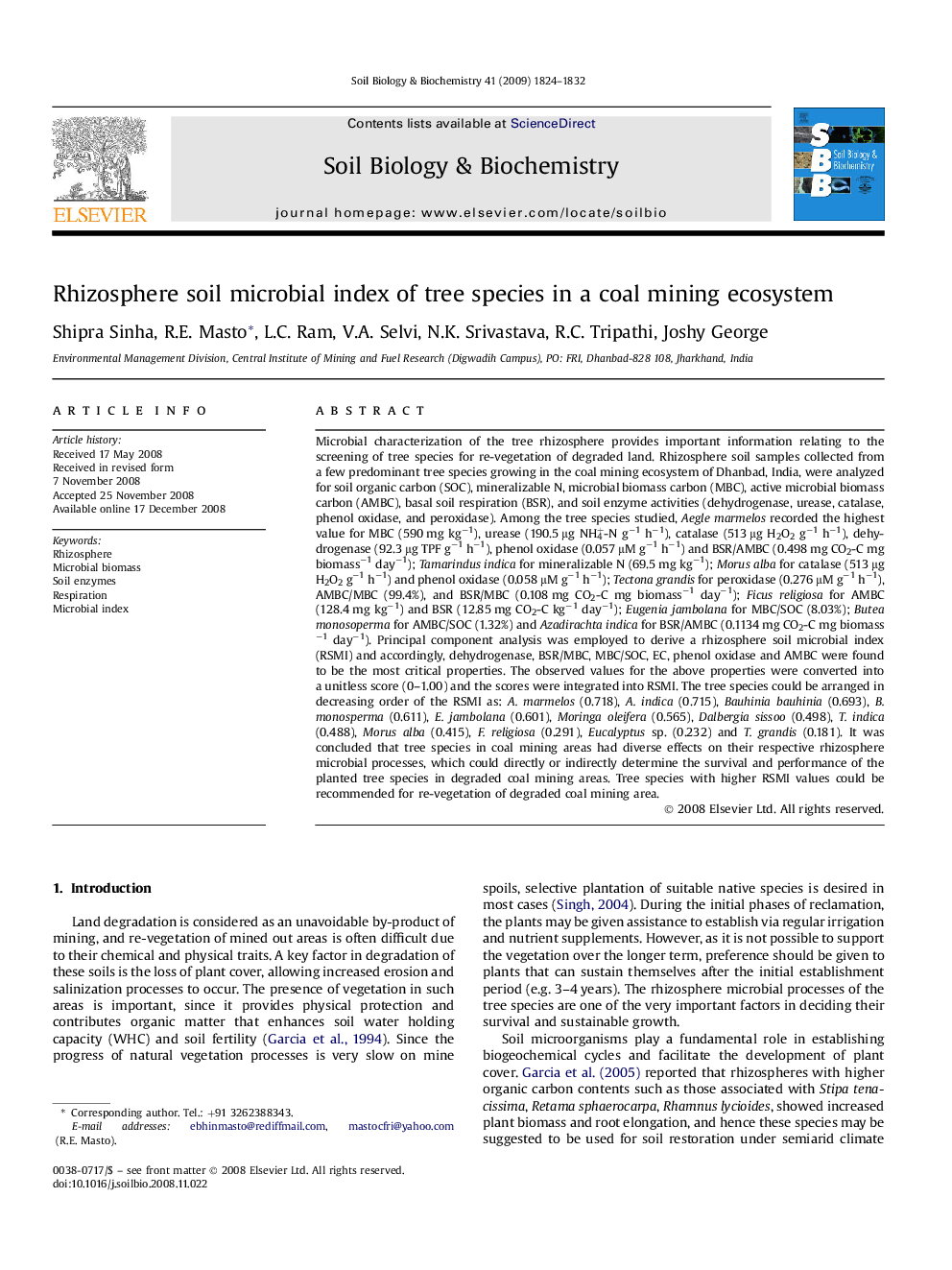| کد مقاله | کد نشریه | سال انتشار | مقاله انگلیسی | نسخه تمام متن |
|---|---|---|---|---|
| 2025572 | 1070003 | 2009 | 9 صفحه PDF | دانلود رایگان |

Microbial characterization of the tree rhizosphere provides important information relating to the screening of tree species for re-vegetation of degraded land. Rhizosphere soil samples collected from a few predominant tree species growing in the coal mining ecosystem of Dhanbad, India, were analyzed for soil organic carbon (SOC), mineralizable N, microbial biomass carbon (MBC), active microbial biomass carbon (AMBC), basal soil respiration (BSR), and soil enzyme activities (dehydrogenase, urease, catalase, phenol oxidase, and peroxidase). Among the tree species studied, Aegle marmelos recorded the highest value for MBC (590 mg kg−1), urease (190.5 μg NH4+-N g−1 h−1), catalase (513 μg H2O2 g−1 h−1), dehydrogenase (92.3 μg TPF g−1 h−1), phenol oxidase (0.057 μM g−1 h−1) and BSR/AMBC (0.498 mg CO2-C mg biomass−1 day−1); Tamarindus indica for mineralizable N (69.5 mg kg−1); Morus alba for catalase (513 μg H2O2 g−1 h−1) and phenol oxidase (0.058 μM g−1 h−1); Tectona grandis for peroxidase (0.276 μM g−1 h−1), AMBC/MBC (99.4%), and BSR/MBC (0.108 mg CO2-C mg biomass−1 day−1); Ficus religiosa for AMBC (128.4 mg kg−1) and BSR (12.85 mg CO2-C kg−1 day−1); Eugenia jambolana for MBC/SOC (8.03%); Butea monosoperma for AMBC/SOC (1.32%) and Azadirachta indica for BSR/AMBC (0.1134 mg CO2-C mg biomass−1 day−1). Principal component analysis was employed to derive a rhizosphere soil microbial index (RSMI) and accordingly, dehydrogenase, BSR/MBC, MBC/SOC, EC, phenol oxidase and AMBC were found to be the most critical properties. The observed values for the above properties were converted into a unitless score (0–1.00) and the scores were integrated into RSMI. The tree species could be arranged in decreasing order of the RSMI as: A. marmelos (0.718), A. indica (0.715), Bauhinia bauhinia (0.693), B. monosperma (0.611), E. jambolana (0.601), Moringa oleifera (0.565), Dalbergia sissoo (0.498), T. indica (0.488), Morus alba (0.415), F. religiosa (0.291), Eucalyptus sp. (0.232) and T. grandis (0.181). It was concluded that tree species in coal mining areas had diverse effects on their respective rhizosphere microbial processes, which could directly or indirectly determine the survival and performance of the planted tree species in degraded coal mining areas. Tree species with higher RSMI values could be recommended for re-vegetation of degraded coal mining area.
Journal: Soil Biology and Biochemistry - Volume 41, Issue 9, September 2009, Pages 1824–1832